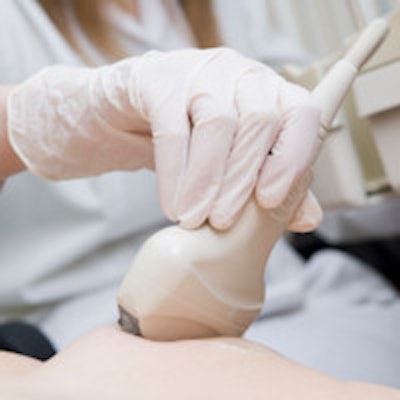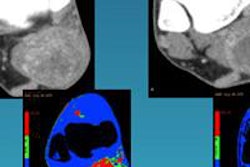
Ultrasound should still be the first imaging test of choice for evaluating patients with suspected nephrolithiasis, according to research published in this week's issue of the New England Journal of Medicine.
The large, multicenter trial compared groups of patients who had been randomly assigned to receive either point-of-care ultrasound by an emergency physician, ultrasound by a radiologist, or an abdominal CT scan as their initial imaging study for suspected nephrolithiasis. The research team, led by Dr. Rebecca Smith-Bindman of the University of California, San Francisco (UCSF), found that using CT first didn't yield better clinical outcomes.
"We found that although ultrasonography was less sensitive than CT for the diagnosis of nephrolithiasis, using ultrasonography as the initial test in patients with suspected nephrolithiasis (and using other imaging as needed) resulted in no need for CT in most patients, lower cumulative radiation exposure, and no significant differences in the risk of subsequent serious adverse events, pain scores, return emergency department visits, or hospitalizations," the researchers wrote.
Risks of CT
Abdominal CT has become the most commonly used initial imaging study for suspected nephrolithiasis; however, the modality comes with radiation exposure, a high rate of incidental findings that can lead to inappropriate follow-up referral and treatment, and added cost, according to the researchers (NEJM, September 18, 2014, Vol. 371:12, pp. 1100-1110).
Because there hasn't been any evidence connecting CT's higher sensitivity with improved patient outcomes, the researchers sought to perform a randomized, multicenter study to compare ultrasound with CT. Patients were enrolled at 15 geographically diverse academic emergency departments from October 2011 to February 2013; 2,759 patients were ultimately included in the study.
The patients first received an imaging study according to the group into which they had been randomized (point-of-care ultrasound, radiology ultrasound, or abdominal CT). They were managed at the discretion of the physician and could be given additional imaging exams.
The researchers compared the 30-day incidence of high-risk complications that could be related to missed or delayed diagnosis, as well as the six-month cumulative radiation exposure. The group also tracked secondary outcomes such as serious adverse events, related serious adverse events that were considered attributable to a patient's participation in the study, pain on an 11-point scale, return visits to the emergency department, hospitalizations, and diagnostic accuracy.
| Accuracy and event rates, ultrasound vs. CT | |||||
| Group | Sensitivity | Specificity | Serious related events1 | All serious events | Radiation dose2 |
| Point-of-care ultrasound | 85% | 50% | 0.3% | 12.4% | 10.1 mSv |
| Radiology ultrasound | 84% | 53% | 0.4% | 10.8% | 9.3 mSv |
| Abdominal CT | 86% | 53% | 0.5% | 11.2% | 17.2 mSv |
2Cumulative radiation dose, which includes follow-up studies after initial exam
The differences in sensitivity and specificity between the ultrasound groups and CT were not statistically significant.
Overall, there were slight differences in adverse events between each imaging group, differences that did not achieve statistical significance. However, the patients in the ultrasound groups -- some of whom received follow-up CT -- had significantly lower mean six-month cumulative radiation exposure than those in the CT group (p < 0.001), which the authors attributed to the imaging performed at the baseline visit.
In terms of serious adverse events (a category that includes all serious events, even those not related to the patient's inclusion in the study), patients in the point-of-care ultrasound group saw a rate of 12.4%, radiology ultrasound a rate of 10.8%, and CT a rate of 11.2%, a difference that was not statistically significant (p = 0.50).
Most importantly, there was no statistically significant difference in related serious adverse events, a category that includes adverse events specifically related to the patient's inclusion in the study, with a rate of 0.3% for point-of-care ultrasound, 04% for radiology ultrasound, and 0.5% for CT, also not statistically significant (p = 0.88).
Finally, each of the three groups had an average pain score of 2.0 after seven days. The groups did not differ significantly with regard to return emergency department visits, hospitalizations, and diagnostic accuracy.





















